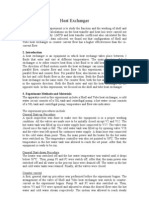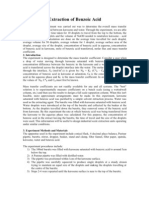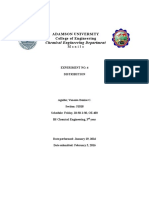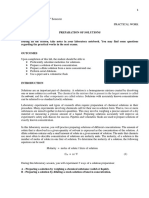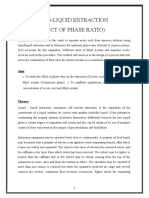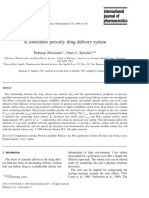Phase Diagram of A Ternary System Lab Report
Uploaded by
JohnConorPhase Diagram of A Ternary System Lab Report
Uploaded by
JohnConorPhase Diagram of a Ternary System
1. Abstract
The purpose this experiment was carried out was to determine the bimodal curve and the
typical tie lines of the water-ethyl acetate-propanoic acid system. The points on the bimodal
curve was determined using the mass fractions of ethyl acetate, water and propanoic acid of
mixtures A to F after the propanoic acid was slowly added until a single phase clear solution
is obtained. The tie line is drawn using the mass fractions of ethyl acetate, water and
propanoic acid of mixtures S, T and U with the ratio of mass of S E/mass of SW using trial and
error method. Three phase diagram will be drawn in this experiment.
2. Introduction
Separation process in which a solute in a feed stream is extracted by contacting the feed with
a solvent is called solvent extraction. The solute has to be soluble in both the feed and solvent
in order for the extraction to take place. The solvent and the feed for industrial extraction
operations are normally partially soluble in one another. A ternary system will be formed
consists of the feed, solvent and solute. The composition of such a system can be
conveniently represented on an equilateral triangle plot with each corner of the triangle
representing one of the three components. In this experiment, the three components are ethyl
acetate (the solvent E), water (the feed W) and propanoic acid (the solute A).
3. Experiment Methods and Materials
The apparatus used in the experiment include conical flask, 100ml measuring cylinder with
stopper, hanging weight of known volume, 4 decimal place balance, top loading balance,
spring balance, vernier callipers, burette, stirrer, dropper, beaker, stand and clamp, filter
funnel, ethyl acetate, water and propanoic acid.
The experiment procedures include:
Determination of Points on the Bimodal Curve
First, a mixture of 20g of water and 4g of ethyl acetate was prepared in a 250ml conical flask.
The mixture is cloudy upon shaking because it is a two-phase system. Water was added
dropwise to find the solubility of ethyl acetate in water. The mixture was shaken until the
solution turns clear. Then, the exact weight of both components was recorded. The procedure
was repeated with the reverse amounts of the two components. Ethyl acetate was then added
to find the solubility of water in ethyl acetate. After that, 2-phase mixtures of ethyl acetate
and water were prepared according to the amounts as shown in the table below. Propanoic
acid was added dropwise and the mixture was kept shaken and more propanoic was added
until a single phase clear solution was formed. The weight of propanoic required to achieve a
clear solution was recorded. Finally, the weights were converted into mass fractions and
plotted on the triangular graph. All the results were recorded and tabulated.
Determination of Tie Lines
First, two-phase mixtures were prepared in a 100ml measuring cylinder according to the
amount as shown in the table below. The cylinder was enclosed with a stopper and was
shaken well. It was then allowed to rest until mixtures have settled in two phase with a clear
interface. The volumes of the aqueous phase (the lower phase) and the organic phase (the
upper phase) for each mixture were read off. After that, the density of the aqueous phase and
that of the organic phase was determined using the hanging weight and digital balance with
the application of Archimedes Principle. The mass, M E of the organic phase and the mass,
MW of the aqueous phase were computed. Then, the ratio M E/ MW for each mixture were
obtained. Finally, tie line for each mixture was plotted using the inverse Lever Rule and the
ratio ME/MW by trial and error method. All the results were recorded and tabulated. Phase
diagrams for the three mixtures were plotted.
4. Data Analysis
The specific results from the experiment allow us to determine the mass fraction, density,
mass and ratio of SE/mass of SW.
Mixtur Ethyl Water Propanoic Ethyl Acetate Water Propanoic
e Acetate (g) Acid (g) Mass Mass Acid Mass
(g) Fraction Fraction Fraction
A 16 2 10.1 0.57 0.07 0.36
B 12 3 12.9 0.43 0.11 0.46
C 10 4 13.4 0.36 0.15 0.49
D 9 7 13.8 0.30 0.24 0.46
E 6 14 20.0 0.15 0.35 0.50
F 2 16 24.2 0.05 0.38 0.57
Mixtur Ethyl Water Propanoic Ethyl Acetate Water Propanoic
e Acetate (g) Acid (g) Mass Mass Acid Mass
(g) Fraction Fraction Fraction
S 40 40 9 0.45 0.45 0.10
T 37 37 15 0.42 0.42 0.16
U 30 40 20 0.33 0.44 0.23
Mixture Initial Final
Volume Volume Force Volume Volume Force Force
(org) m3 (aq) m3 (in air)N (org) m3 (aq) m 3
(org) N (aq) N
S 0.000049 0.000042 0.3 0.000052 0.000046 0.28 0.23
T 0.000054 0.000041 0.3 0.000058 0.000044 0.26 0.24
U 0.000053 0.000043 0.3 0.000056 0.000046 0.26 0.26
Mixture Density, ρ Density, ρ Mass of Mass of Ratio of Mass of SE/
(org) (aq) SE (org) g SW (aq) g Mass of SW
S 679.5787 1783.8940 2.0387 7.1356 0.2857
T 1019.3680 2038.7360 4.0775 6.1162 0.6667
U 1359.1570 1359.1573 4.0775 4.0775 1.0000
5. Discussion
The bimodal curve was drawn using the mass fractions of ethyl acetate, water and propanoic
acid of mixtures A to F after the propanoic acid was slowly added until a single phase clear
solution is obtained. The densities for organic phase and water phase are calculated using ∆
Forg = ρorg ∆ Vorgg and ∆ Faq = ρaq ∆ Vorgg. The mass of SE and SW are calculated by ρorg∆
Vorg × 1000 and ρaq∆ Vorg × 1000. The tie line was then drawn using the mass fractions of
ethyl acetate, water and propanoic acid of mixtures S, T and U with the ratio of mass of
SE/mass of SW. Relationship of Mass of SE/Mass of SW = Length of line SSW/Length of line
SES also used in drawing the tie line by trial and error method. The tie line for mixture S was
unable to draw because of the errors occurred during the experiment. These errors include
that the propanoic acid was added in excess or insufficiently. Hence, the amount of the
solution needed for the mixture to turn clear may excesses the actual amount needed. Besides
that, the solution was not confirmed 100% clear. The sensitivity of the measurement of the
force was not good enough. Accuracy of the points draws using free hand may not accurate
enough. The decimal places used in the calculation will also affect the results.
6. Conclusion
As a conclusion, the orientation of the tie line and the bimodal curve together determine the
composition of phase SE and SW that are equilibrium with one another. In order to get more
accurate results, the experiment should be repeated several times. Application of this
experiment is the extraction of metal in industry or extraction of solution in lab experiment.
You might also like
- Experiment 3: Ternary Phase Diagram (Liquid-Liquid Extraction)100% (1)Experiment 3: Ternary Phase Diagram (Liquid-Liquid Extraction)15 pages
- Objective: Determination of Partition Co-Efficient of Acetic Acid Between Water and N-Butanol100% (1)Objective: Determination of Partition Co-Efficient of Acetic Acid Between Water and N-Butanol5 pages
- Experiment 4 - Distribution (Formal Report)100% (6)Experiment 4 - Distribution (Formal Report)5 pages
- Kinetic Study of The Reaction Between Iron (III) Ions and Iodide Ions100% (1)Kinetic Study of The Reaction Between Iron (III) Ions and Iodide Ions11 pages
- Phase Diagram of A Three Component Liquid System: Experiment No. 50% (1)Phase Diagram of A Three Component Liquid System: Experiment No. 57 pages
- Experiment - Phase Diagram - Three Component Liquid System50% (2)Experiment - Phase Diagram - Three Component Liquid System12 pages
- Adsorption of Acetic Acid On Charcoal Surface90% (10)Adsorption of Acetic Acid On Charcoal Surface3 pages
- Q2015 Physical Chemistry Measurements Laboratory Chemistry Department, Campus Monterrey Practice # 8 Distribution Coefficient100% (1)Q2015 Physical Chemistry Measurements Laboratory Chemistry Department, Campus Monterrey Practice # 8 Distribution Coefficient4 pages
- Liquid - Liquid Extraction in A Packed Bed: Experiment No: 2No ratings yetLiquid - Liquid Extraction in A Packed Bed: Experiment No: 223 pages
- Chemical Engineering Laboratory - AgitationNo ratings yetChemical Engineering Laboratory - Agitation6 pages
- Title Uv-Vis Determination of An Unknown Concentration Kmno SolutionNo ratings yetTitle Uv-Vis Determination of An Unknown Concentration Kmno Solution4 pages
- Batch Sedimentation Post-Laboratory Experiment 4No ratings yetBatch Sedimentation Post-Laboratory Experiment 48 pages
- Experiment 4 The Determination of Partial Molar Enthalpy100% (1)Experiment 4 The Determination of Partial Molar Enthalpy29 pages
- Determination of Heat of Solution by Solubility Method.: Experiment: 01100% (1)Determination of Heat of Solution by Solubility Method.: Experiment: 013 pages
- Spectrometric Determination of The Acid Dissociation Constant of Methyl RedNo ratings yetSpectrometric Determination of The Acid Dissociation Constant of Methyl Red11 pages
- CE - Experiment 2 Extraction With Acid and AlkalineNo ratings yetCE - Experiment 2 Extraction With Acid and Alkaline8 pages
- Liquid-Liquid Extraction (Effect of Phase Ratio)No ratings yetLiquid-Liquid Extraction (Effect of Phase Ratio)21 pages
- Experiment 3: Pulsed Column Liquid-Liquid Extraction UnitNo ratings yetExperiment 3: Pulsed Column Liquid-Liquid Extraction Unit13 pages
- Chapter - 8 - Chemical - Reactions - and - Equations 2No ratings yetChapter - 8 - Chemical - Reactions - and - Equations 213 pages
- June 2014 (v1) QP - Paper 6 CIE Chemistry IGCSENo ratings yetJune 2014 (v1) QP - Paper 6 CIE Chemistry IGCSE12 pages
- Dosage Form Design: Pharmaceutical and Formulation ConsiderationsNo ratings yetDosage Form Design: Pharmaceutical and Formulation Considerations103 pages
- Tests For Alcohols - MeitY OLabs - English (United Kingdom)No ratings yetTests For Alcohols - MeitY OLabs - English (United Kingdom)4 pages
- Atomic Energy Central School-Kudankulam: Time Allowed: 1 Hour and 30 Minutes Maximum Marks: 35 General InstructionsNo ratings yetAtomic Energy Central School-Kudankulam: Time Allowed: 1 Hour and 30 Minutes Maximum Marks: 35 General Instructions8 pages
- Parameters Determination For Column Design in Gas AbsorptionNo ratings yetParameters Determination For Column Design in Gas Absorption7 pages
- Gravimetric Analysis and Precipitation - TitrationsNo ratings yetGravimetric Analysis and Precipitation - Titrations34 pages
- Practical Booklet-2 For AS and A Level ChemistryNo ratings yetPractical Booklet-2 For AS and A Level Chemistry11 pages
- Organic Chemistry Lab Caffeine ExtractionNo ratings yetOrganic Chemistry Lab Caffeine Extraction8 pages
- Pharmaceutical and Formulation Consideration Biopharmaceutical and Pharmacokinetic ConsiderationNo ratings yetPharmaceutical and Formulation Consideration Biopharmaceutical and Pharmacokinetic Consideration41 pages


